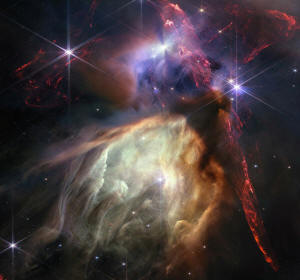NASA releases Webb telescope images of a galactic merger
 Send a link to a friend
Send a link to a friend
 [July 13, 2024]
By Will Dunham [July 13, 2024]
By Will Dunham
WASHINGTON (Reuters) - NASA released on Friday a pair of images taken by
the James Webb Space Telescope showing two galaxies - one nicknamed the
Penguin and the other the Egg - in the process of merging in sort of a
cosmic ballet as the U.S. space agency marked two years since it
unveiled the orbiting observatory's first scientific results.
Webb, which was launched in 2021 and began collecting data the following
year, has reshaped the understanding of the early universe while taking
stunning pictures of the cosmos. The two galaxies in the images are
situated 326 million light-years from Earth in the constellation Hydra.
A light year is the distance light travels in a year, 5.9 trillion miles
(9.5 trillion km).
"We see two galaxies, each a collection of billions of stars. The
galaxies are in the process of merging. That's a common way that
galaxies like our own build up over time, to grow from small galaxies -
like those that Webb has found shortly after the Big Bang – into mature
galaxies like our own Milky Way," said Jane Rigby, NASA Webb senior
project scientist.
Since becoming operational, Webb has observed galaxies teeming with
stars that formed within a few hundred million years of the Big Bang
event that marked the beginning of the universe about 13.8 billion years
ago.
The mingling Penguin and Egg galaxies are collectively known as Arp 142.
They are shown in the imagery joined by a haze that is a mix of stars
and gas amid their slow-motion merger.

The Penguin galaxy, so dubbed because its shape from the perspective of
the telescope resembles that flightless bird, including a beak-like
region, is formally called NGC 2936. It is a spiral-shaped galaxy, now a
bit distorted. The Egg galaxy, also named for its shape, is formally
called NGC 2937. It is a compact elliptical-shaped galaxy. Together,
their appearance is suggestive of a penguin guarding its egg.
Their interaction, according to NASA, was set in motion between 25 and
75 million years ago, and they are expected to become a single galaxy
hundreds of millions of years from now.

[to top of second column]
|

The Rho Ophiuchi cloud complex, the closest star-forming region to
Earth, is seen in a composite of separate exposures acquired by the
James Webb Space Telescope using the NIRCam instrument released July
12, 2023. NASA, ESA, CSA, STScI, Klaus Pontoppidan and Alyssa
Pagan/Handout via REUTERS/ File Photo

Webb has detected the earliest-known galaxies and has provided
insight into areas such as the composition of planets beyond our
solar system, known as exoplanets, and the nature of star-forming
regions in the cosmos.
"This mission has allowed us to look back to the most distant
galaxies ever observed and understand the very early universe in a
new way," said Mark Clampin, astrophysics division director at NASA
headquarters. "For example, with Webb, we've found that these very
early galaxies are more massive and brighter than we expected,
posing the question: How did they get so big so quickly?"
Webb was designed to be more sensitive than its Hubble Space
Telescope predecessor, which also is continuing its work. Webb looks
at the universe mainly in the infrared, while Hubble has examined it
primarily at optical and ultraviolet wavelengths.
"Webb is the largest, most powerful telescope ever put in space. It
specializes in capturing infrared light - wavelengths of light
longer than our eyes can see. With its incredible sensitivity to
those wavelengths, we've been able to look back into the early
universe in a way previous missions couldn't, see through dust and
gas into the heart of star formation, and examine the composition of
exoplanet atmospheres like never before," Clampin said.
Looking ahead, Clampin added, "Some of Webb's most exciting
investigations will be the things we haven't even thought of yet."
(Reporting by Will Dunham, Editing by Rosalba O'Brien)
[© 2024 Thomson Reuters. All rights
reserved.]This material
may not be published, broadcast, rewritten or redistributed.
Thompson Reuters is solely responsible for this content. |